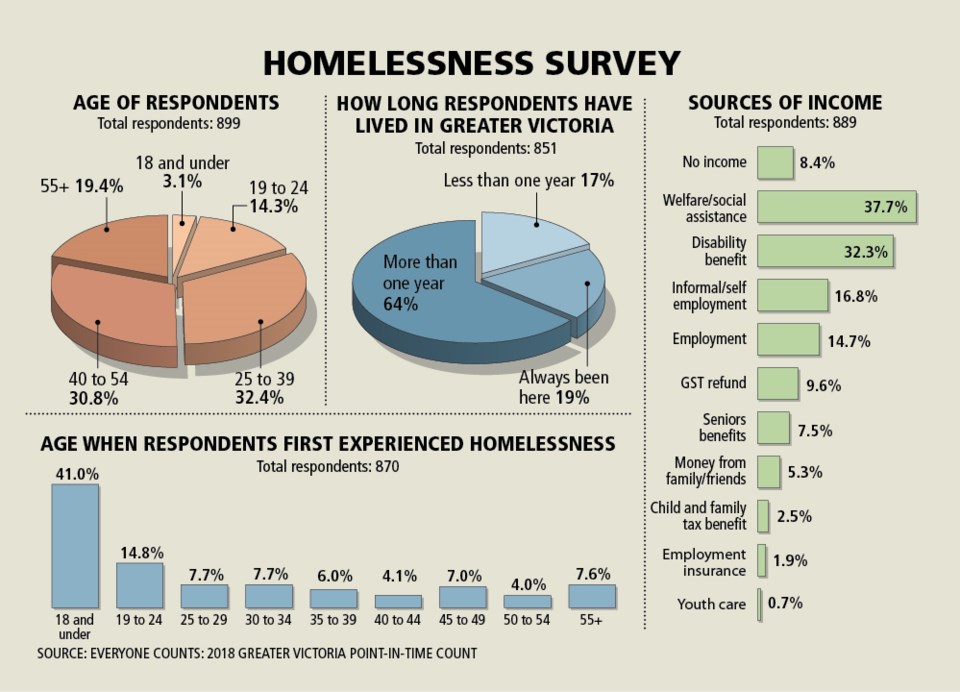The number of people found without shelter and sleeping outdoors in Greater Victoria was down 18 per cent from 2016, according to a recent survey, but there are concerns about how Indigenous people, youth and seniors are faring.
The 2018 Greater Victoria Point-in-Time Count, conducted on March 15, provides a snapshot of the homeless situation in the area — just as a similar effort did in 2016. Surveys were conducted this year in 60 communities across Canada, although results have not been compiled for comparison.
In Greater Victoria, the count was led by the Capital Regional District in partnership with the Community Planning Council and the Greater Victoria Coalition to End Homelessness, with backing from the federal Homelessness Partnering Strategy.
Stefanie Hardman, research manager with the Community Social Planning Council, said this year’s effort had more volunteers taking part than before and was focused on getting to additional hard-to-reach people.
The data collected “helps to inform service planning and delivery in the region,” Hardman said.
“We can get a better sense especially of who is experiencing homelessness and for what reasons, and what are the local service needs around that.”
There were 1,525 people counted, with 906 agreeing to take part in the survey.
Of those, 158 people were unsheltered and sleeping outdoors, down from 192 in 2016. Seventy-seven were unsure of where they would be sleeping, 359 were staying in an emergency shelter, and 909 were staying in provisional accommodation such as transitional housing, treatment or correctional facilities, or couch surfing.
The 2016 count total was 1,387. Organizers say the higher number this year is not an indicator of increased homelessness, but is due to a change in methodology and improved outreach efforts.
Victoria Mayor Lisa Helps, who co-chairs the Greater Victoria Coalition to End Homelessness, said some of the results “should really alarm all of us as Canadians.”
That includes the fact that Indigenous people made up 33 per cent of respondents despite the fact that they make up only 4.7 per cent of the overall population — something Hardman called “a severe overrepresentation.”
Hardman said another issue is the fact that 41 per cent of respondents first experienced homelessness at 18 years old or younger.
“That’s one of the key findings of the Point-in-Time Count, for sure, demonstrating the critical age of youth homelessness and how that may result in experiences of homelessness throughout life,” she said.
The count said that youth can often be classified as “hidden” homeless because they “couch surf” with friends.
Close to one-fifth of those surveyed — 19.4 per cent — were 55 or older.
“This year the survey results focused in on seniors,” Helps said. “A significant portion of people 55 and over — these are our senior citizens living on the street.”
She said the top reason seniors listed for being homeless was the cost of accommodation.
“So what kind of region is it where seniors can’t afford to pay for housing?”
Still, Helps said, there is some promise in the decrease of homeless counted this year compared with 2016.
“The numbers are useful, but what’s most useful about this process is the rich information we get, and now it gives us, once again, a renewed focus on Indigenous people, youth and seniors because those are groups that have significant barriers to the current housing system.”
She stressed that the count was done prior to the emergence of the homeless camp currently in Saanich’s Regina Park.
“It would be interesting to know how many of the people who were counted on March 15 ended up at the camp in Saanich,” she said.
Helps said a “silver lining” to the count is the $90 million in the Regional Housing First Program, which will help tackle the issues being raised. The funds are made up of $30 million each from the regional, provincial and federal governments.
“That will make a dent,” she said.
Here are some other findings from the survey:
• 67.6 per cent of respondents identified as male and 30.2 per cent as female.
• 78.8 per cent reported having been homeless for over six months in the past year.
• Of those responding, 83 per cent had lived in the Victoria area for over a year while 56.7 per cent had lived elsewhere in the province before coming to the capital region.
• The vast majority is not homeless by choice, with 93.7 indicating a desire for permanent housing.



